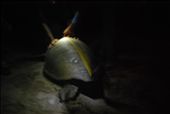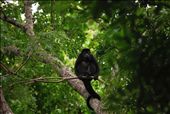I’ve spent a fair amount of time hiking in the jungle but almost never at night and definitely never at this pace. Four of us were moving quickly through the rainforest, hurrying to the sea turtle nesting beach at the end of the trail, in the hopes of arriving in time to put a satellite transmitter on a black turtle currently on the beach. The rumble of far-off thunder faded into the sound of crashing waves as we crested a hill near the end of the trail.
Our destination was Brasilon Beach, within the La Flor Wildlife Refuge in the southwestern corner of Nicaragua. This beach is one of several turtle nesting beaches along this stretch of coast protected by Paso Pacifico, an innovative young conservation organization. Paso Pacifico focuses on protecting the “Paso del Istmo”, an incredibly beautiful 12-mile stretch of land between Lake Nicaragua and the Pacific Ocean.
My visit started in Managua, where I was picked up by Liza Gonzalez, Paso Pacifico’s Country Director, on the way to the isthmus. I can’t imagine a better guide than Liza, who intimately knows the region and its residents. She’s held lofty positions in the government (she was formerly director of the National Protected Areas System) but her passion for spending time in the field and with the people who depend on natural resources was obvious. Along with us were Sarah Rudeen, an intern, and Wendy Purnell, who supports Paso Pacifico’s fundraising efforts in the US.
 Along the way, we made a quick stop in Granada, the beautiful colonial town on the edge of Lake Nicaragua. Strolling through the market in front of the dramatic cathedral, I found more hawksbill turtle jewelry for sale than any other place I’ve been in Latin America. This reminder of how much work remains to be done helped to set my perspective for the visit.
Along the way, we made a quick stop in Granada, the beautiful colonial town on the edge of Lake Nicaragua. Strolling through the market in front of the dramatic cathedral, I found more hawksbill turtle jewelry for sale than any other place I’ve been in Latin America. This reminder of how much work remains to be done helped to set my perspective for the visit.
The view from the car gradually changed from open pastureland to intact forest as we went south. We passed through San Juan del Sur, a growing tourist town that is the main stopping point for backpackers in this area. Liza, Wendy, Sarah, and others had just spent an exhausting week helping to clean up from an international surfing event. Before arriving at our ultimate destination, Ostional Beach, we saw beautiful nature murals on local schools, ate at a restaurant supported by the organization, and passed areas their reforestation project is restoring. Paso Pacifico’s impact is visible almost everywhere you go in this region.
At Ostional, we arrived to the Manta Ray hostel, where we were staying for two nights. Walking out to the beach, I was stunned by the dramatic view. The rolling rocky coast of Nicaragua and northern Costa Rica stretches across the entire horizon giving the impression of a huge bay. After nightfall, the only visible lights were bright stars and the far off overdeveloped resort area of Papagayo, Costa Rica, a reminder of the type of coastal development that many local residents hope to avoid in this region. Here we met up with Marvin Chevez, a ranger with Paso Pacifico and a former student in an ecotourism class that I teach at Mt. Hood Community College. Marvin had just returned to Ostional after two years of living in Oregon and is putting his new degree to good use in the reforestation program.
We headed out by boat to explore the spectacular stretch of coast, possibly the most beautiful and dramatic of coastline that I’ve ever seen (and I live in Oregon). Crashing waves batter sloping flat rocks and white sand beaches hide behind rocky-forested outcrops. Moving north along the coast of the wildlife refuge, we stopped in front of La Flor beach, one of a handful of beaches in the world that host the arribada, a mass nesting event of olive ridley sea turtles. My years of experience being quiet around turtles on nesting beaches went right out the window as I let out a yell as a small head popped out of the water not far from our boat. The turtle heard me and dropped right back into the water, but there were plenty more bobbing around.
That evening, we hiked to Brasilon, unaware of the weather that was on its way. Catching our breath upon arrival to the beach, we checked in with the rangers who let us know this turtle wasn’t suitable for a transmitter (her shell was too thin). Before the female black turtle (as known as the Pacific green turtle) headed back to the ocean, we collected her data and let her on her way. As the turtle got wet, so did we as a light rain began to fall.
 Anticipating a wet return hike, we set off up the steep trail again as lightning approached. The hike back through the forest challenged my ability to concentrate; our pace increased and the trail became slick. I desperately tried to keep my camera dry while avoiding slipping on the rocks and mud. When we finally reached the end of the trail, not one dry spot remained on anyone.
Anticipating a wet return hike, we set off up the steep trail again as lightning approached. The hike back through the forest challenged my ability to concentrate; our pace increased and the trail became slick. I desperately tried to keep my camera dry while avoiding slipping on the rocks and mud. When we finally reached the end of the trail, not one dry spot remained on anyone.
The next day, sun shining once again, we visited La Flor beach. Though a small arribada of roughly 1,000 turtles had happened three days before, there was little evidence of turtles on the beach. At its peak, La Flor can host up to fifty thousand turtles during an arribada. With so many turtles, the refuge’s rangers can have a hard time protecting the nests on the edge, which often get poached for sale on the black market.
A short drive took us from La Flor to Hostal Don Miguel, a charming new small hotel owned by local residents. Don Miguel is participating in Paso Pacifico’s reforestation program and hosts a nursery for native trees used throughout the region. Nicaragua has been hard hit by deforestation but Paso Pacifico’s award-winning program has helped to restore more than 1,000 acres to rainforest. This inspirational project not only helps recover wildlife habitat, it also helps to create jobs, absorb carbon in the air, and prevents erosion and flooding.

While a student in my class, I had Marvin promise to take me on a kayak tour. Unfortunately, he hadn’t warned me just how big the waves at his beach were. After a couple of attempts to pass the waves (on a kayak built for rivers) and a couple of times being tossed into the water, we figured walking the kayaks to the nearby estuary was a better idea. The quiet river was a big contrast to the crashing ocean though the calm was broken when Marvin’s howler monkey imitation awoke a big group sitting in a nearby tree.
The haunting call of the howlers stayed with me the next day as I headed to the airport to head back to Portland. After 10 days in two countries (El Salvador and Nicaragua), visiting four turtle beaches, spending 25 hours in cars and buses, numerous boat rides, and staying at 6 hotels and cabins, I was ready to head home. The dozens of local and international turtle conservationists that I met on this trip have given me hope that, despite large threats and little funding, the sea turtles living along this stretch of coast have a chance not only to survive, but to thrive.
SEEtheWILD Nicaragua Wildlife Vacations:
-Nicaragua’s Wild Side
-Nicaragua Wildlife Adventure
-Cloud Forests, Reefs, & Sea Turtles